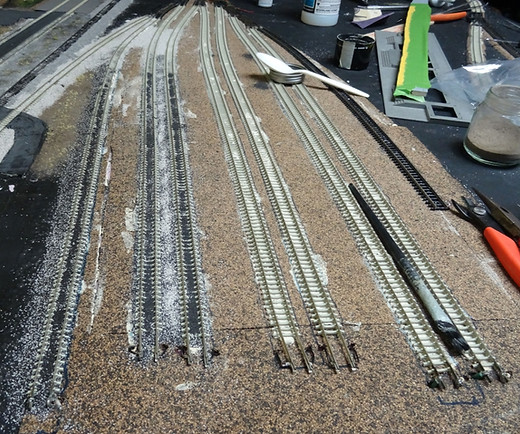Carletta Trains
Building the Hoboken Terminal
Constructed in 1907 the Erie Lackawanna terminal is in Hoboken, NJ and is serviced by New Jersey Transit, Metro North, and the P.A.T.H. which takes commuters under the Hudson River into New York City. While my model isn't exact, it's the best I could do with the space and materials available. I had hoped to construct the train shed and have the materials, but it's as much bigger task than it seems.
The station is actually the Walthers Union Station kit which I modified for roof height and filled in the lines on the brick exterior to replicate the copper siding
The Station



The Tracks

The Construction
With all the track laid and wired it's time to paint the ground black to prep for the scenery



Here you can see where I outlined where the road to the terminal and beyond will be. There will be an underpass to get from the main layout to the extension. I opted for this instead of as grade crossing because of how the track is laid out.
Here's the fist pour of Woodland Scenics Smooth-It road cement


This picture shows Woodland Scenics foam putty in a shallowed out area that will be a marsh. IA needed to cover it in putty to give it a smooth bottom otherwise it'd be prickly from shallowing process.
i wanted this part of the level to have grades and not be perfectly flat. I used a Dremel with a sanding attachment to grind down the foam board so it looks like it's gradually getting lower and that the railroad workers had to build the land up to keep the tracks level.
Once I finished with the Dremel I used the foam putty to fill areas what had nicks and cuts where I pushed too hard.


In the middle of this photo you can see the access road in white which leads up to the gray flooring for the maintenance facility.
Also in this picture at the bottom left you can see me test fitting a couple of the terminal platforms which are made out of balsa wood.
You can also see that I began to add ballast to the tracks.
Here you can see all four balsa wood platforms being tested for a nice fit. I also tested pushing cars down each track to make sure that they didn't brush against the platforms.

Now that the platform testing was done it was time to paint them. Before painting I scored each of them to make it look like slabs of concrete and then I painted them gray. Once that dried I masked them off with tape and painted the yellow safety line.



I added ballast to the station tracks being careful not to put any on the outside of the ties so that the platforms will still fit.
I continued by ballasting the maintenance yard. Once the ballast was dry I went back with a paintbrush and blotted the ballast with thinned black paint to give it the look of dirt and oil built up from years of service. I also added the marsh on the right.

I trimmed down the ballast in the service area and added the second marsh. You can see I just poured the Woodland Scenics Realistic Water. Before pouring the water I glued some reeds in.
You'll notice that I painted the bottom a brown and green color so the water will look murky and stale.

Once the ponds thoroughly dried I added ground foam and bushes


Now that I had the scenery around the terminal completed I installed the station platforms. The layout has a slight curve to it so I used weights to ensure that the platforms will adhere to the curvature of the layout.

The station is just about complete. The only thing left to do is install the fencing between the rails.

Here are some track level photos of the completed platforms
I had extra room to add extra structures but I decided to keep it simple. I added a Staples store, a factory with a siding and a hill with a diner and perhaps a small house. As you saw above, most of the scenery has already been done. There was still one corner that had nothing on it. That's where the diner (and maybe a small house) will go.
After shaping this pink insulation board and painting it black I used Woodland Scenics Foam Putty to smooth over rough areas and to make the hill smoother.


Since I needed to extend my road from the original layout I took the opportunity to redo an area where I did a poor job when I first built it.
You can see that the ground foam is still saturated with the glue and wet water (50% rubbing alcohol 50% water). You can also see that the painted street is shiny because it's also wet. There's a chance is could stain the street which is why you should generally cover it. You can't wipe it off because it will remove the paint.

The picture on the left shows the hill with the ground foam drying with the wet water and white glue mixture.
The picture on the right shows the same area with bushes and coarse turf added.


Pictures of the finished areas








